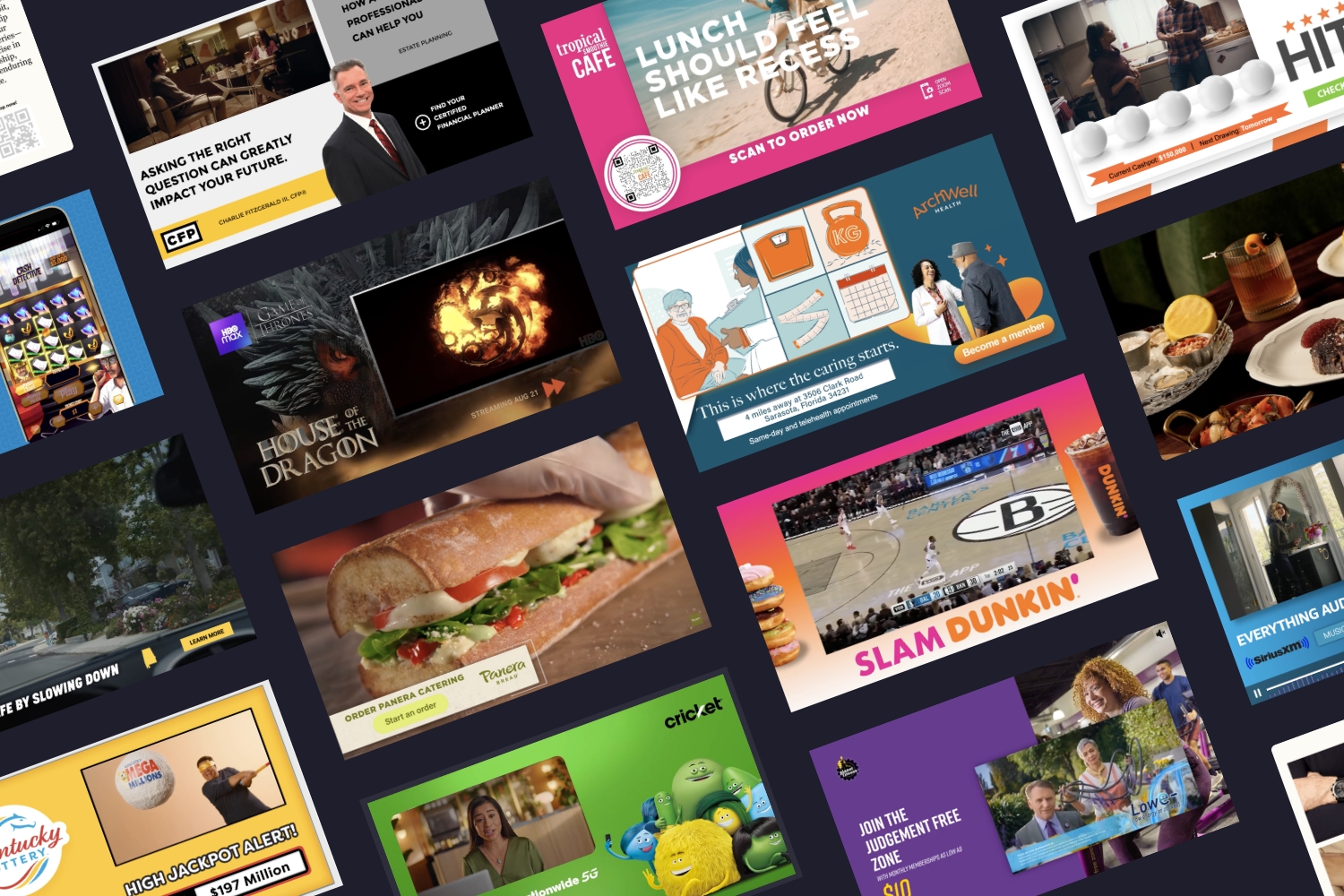Is your ad frequency too hot, too cold, or just right?
How often customers see your ads is the ultimate Goldilocks problem of digital marketing. Your audience is searching for that perfect balance.
Too many ads overwhelm—72% of consumers find irrelevant ads disruptive. But too few, and 80% of users won’t recognize or trust your brand.
The challenge? Goldilocks is already drowning in noise. The average American sees 4,000 to 10,000 ads daily, yet only about 100 actually register.
Striking the balance between being memorable and maddening is no easy task. Get it “just right,” and you’ll craft a seamless, engaging digital experience that stands out and drives action.
Here’s how to nail it—and why it matters.
What is a good ad frequency?
The recommended initial ad frequency depends on your campaign goals and audience.
- For brand awareness, an ad frequency of 3-5 impressions per day is often ideal, allowing your brand to stay memorable without overwhelming users.
- For conversion campaigns, a slightly higher frequency of 5-10 per day can work better to encourage action.
The above ad frequency recommendations are ideal to start out your campaign. As you gather more user data, the frequency may be toggled up or down.
What is ad frequency?
Ad frequency is a critical metric for digital marketers.
Finding the right balance between reinforcing your message and overwhelming your audience can determine the success of your campaign.
Ad frequency = how often a person sees your ad within a set time frame
Different platforms may measure it slightly differently, but the goal remains the same: balancing exposure and effectiveness.
Getting ad frequency right can significantly improve engagement and ROI, but mismanaging it risks audience fatigue, wasted ad spending, and damaging a brands’ image.
Optimizing this metric is crucial for running effective ad campaigns.
Why Ad Frequency Matters
Managing how often your audience sees your ads keeps your brand top-of-mind while building positive impressions. Mastering frequency drives awareness, conversions, and smarter campaigns.
Brand Awareness: Moderate frequency improves recall and ensures your brand stands out.
Conversions: Optimal frequency guides customers from interest to action without being intrusive.
Ad Fatigue: Too many ads can irritate and disengage your audience. Balance is key.
Budget Efficiency: Proper frequency avoids wasted impressions and oversaturation.
Reach: Frequency caps help expand your audience by reaching more people early on.

How do audience segmentation or targeting factors affect your frequency decisions?
“Campaigns are launched with a frequency of 3-5 impressions per day. Narrowing an audience will decrease the number of eligible ad delivery targets. If we’re having trouble delivering, we may need to increase the daily frequency or implement a ‘recency’ cap instead. However, our goal is never to have a potential target experience an adverse reaction to a brand, so we want to avoid bombarding them with many ads. I would rather find other relevant audiences to add to the targeting pool.”
Stephanie Taylor, Digital Ad Operations Specialist, KORTX
How to Calculate Ad Frequency
Ad frequency is calculated by dividing the total number of impressions by the unique reach. In other words:
Ad Frequency = Total Impressions / Unique Reach
This formula helps you monitor how often users see your ad, ensuring your strategy avoids overexposure.
The Psychological Effects of Ad Frequency
Ad frequency shapes how audiences perceive your brand, leveraging psychological principles to build trust and familiarity.
Processing Fluency: Repeated exposure makes your brand feel familiar and easier to recognize—like reconnecting with an old friend.
Illusory Truth Effect: Consistent messaging boosts credibility, making consumers more likely to trust repeated claims.

How do you identify signs of ad fatigue, and what steps do you take to combat it?
“I’ve run many CTR and conversion campaigns that target the same niche audiences month after month, using the same creative and in the same geographic area. These campaigns start out strong, but after several months, the CTR starts to drop steadily, page views decrease, etc. I prefer to combat that with fresh creative, especially if the audience is niche and it’s hard to expand.”
Stephanie Taylor , Digital Ad Operations Specialist, KORTX
Best Practices for Setting Ad Frequency Caps
Frequency caps optimize your budget and audience experience.
The goal is to strike the perfect balance—engaging your audience without causing fatigue.
Here’s how to fine-tune your frequency strategy for optimal results:
- Set Frequency Caps: To prevent oversaturation, set clear limits on how often your ads appear based on campaign goals, platform(s), and audience behavior.
- Leverage Frequency Management Tools: Platforms like Google Ads and Meta Ads Manager help you monitor and control ad exposure.
- Test and Learn: A/B testing helps you find the sweet spot for engagement without oversaturation.
- Segment Your Audience: Customize frequency caps by audience segment. Some groups may need frequent touchpoints, while others prefer a lighter approach.
- Rotate Creative Assets: Keep your ads fresh by rotating creatives.
✨ How KORTX Balances Frequency & Trust in Every Campaign ✨
KORTX’s frequency framework is designed to uphold brand integrity by ensuring advertising experiences are delivered at safe and responsible frequencies. This dynamic approach begins campaigns with an initial frequency of 3-5 impressions per day, sometimes incorporating minute or hourly intervals between exposures. As campaign data accumulates, the frequency rate is tailored to optimize performance while maintaining audience respect and trust.
Algorithmic Ad Frequency vs. Human Oversight
The decision regarding whether to let algorithms manage ad frequency or to use manual caps centers on individual preferences and campaign goals.
Algorithms offer efficiency and scalability, automatically adjusting frequency based on engagement and data. However, human intervention ensures alignment with brand strategy, market conditions, and creative nuances.
Both approaches are valid.
What matters most is consistent monitoring and adjustments. Whether you rely on algorithms or set your caps, prioritize what’s essential: reach, brand safety, and performance optimization. Blending algorithmic precision with human strategy will help create effective, balanced campaigns.
The Impact of Creative on Ad Frequency
Creative plays a pivotal role in optimizing ad frequency, serving as the foundation for audience engagement and campaign success. High-quality, fresh, and strategically varied ad creatives can make the difference between captivating your audience and overwhelming them.
Here’s how creative impacts ad frequency:
- Refresh Creative Content Regularly: Updating visuals and messaging keeps your campaign fresh. Regular changes prevent audience fatigue and keep your ads relevant, especially when running longer campaigns or reaching audiences across multiple channels. At a minimum, creative should be updated quarterly.
- Focus on Ad Quality: Quality matters. High-quality ads resonate with audiences, reducing the need for excessive frequency. Conversely, low-quality creatives often require multiple exposures to achieve impact, which can lead to overexposure and negative brand perceptions.
- Test & Rotate Creative Assets: A/B testing and rotating fresh visuals or messages help maintain audience interest and prevent ad fatigue. The number of creative variations in rotation also influences daily frequency and the need for timely content refreshes.
- Personalization Through Dynamic Creative Optimization (DCO): Tools like DCO enable real-time personalization, adjusting ad content based on audience behavior and preferences. This ensures your ads remain relevant and engaging, enhancing the effectiveness of your campaigns while avoiding redundancy.

How can strategies like rotating creatives or message sequencing to mitigate fatigue?
“Frequency isn’t always created equal, and having a ‘high’ frequency isn’t necessarily a bad thing. When you reach your audience using a variety of ad placements (video, display, etc.) or multiple creative variants (headline changes, imagery swaps, etc.), the user experience is far more positive compared to relying on a single creative message and format.”
Gunnar Eisenmenger , Senior Account Manager, KORTX
Advanced Strategies for Ad Frequency Management
Elevate your ad frequency strategy with advanced techniques that maximize engagement while keeping your campaigns efficient and effective. From tailored audience strategies to smarter creativity, these methods ensure your ads resonate without overreaching.
- Audience Segmentation for Personalized Frequency: Adjust your approach for different audience segments. New customers may need more touchpoints to build familiarity, while loyal returnees thrive on fewer, more meaningful interactions.
- Dynamic Creative Optimization (DCO): DCO automatically adapts content based on user behavior, preferences, and engagement patterns to keep your ads fresh and relevant.
- Cross-Platform Analytics: Leverage tools like GA4 or Kampus to maintain consistent ad exposure across platforms. By keeping frequency unified and intentional, you can avoid frustrating your audience with the same ad appearing everywhere.

What are the common challenges you face when implementing frequency caps across platforms?
“Platforms are often siloed from one another, making managing frequency across programmatic, social, and search channels nearly impossible. One solution is to use a 1P audience that works across these platforms. This allows you to compare reach and frequency consistently, giving you an apples-to-apples view across digital channels.”
Gunnar Eisenmenger , Senior Account Manager, KORTX
Suggested Frequency Benchmarks by Campaign Type
Different campaign types require varying frequency benchmarks to achieve their goals effectively. These recommendations are a starting point and should be adjusted based on insights gained from your campaigns.
- Brand Awareness: 3-5 impressions to build familiarity without oversaturation.
- Conversions: 5-10 impressions to encourage action.
- Sales-Focused Campaigns: Around 3 impressions per day.
- B2C Campaigns: 3-5 impressions per week.
- B2B Campaigns: 3-4 impressions per month, reflecting longer buying cycles.
Continuously monitor and refine frequency to optimize performance and align with audience behavior.
Avoid Ad Burnout with Smart Frequency Strategies
Managing ad frequency is both an art and a science. When done right, it keeps your audience engaged, reinforces your message, and maximizes your budget. But finding that Goldilocks zone requires careful planning, testing, and optimization.
About the Author
Bryan Presti is the Head of Programmatic Trading at KORTX.

